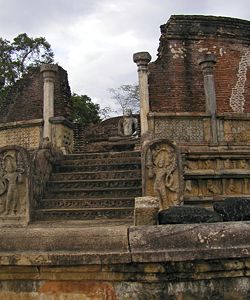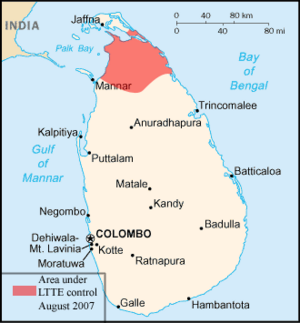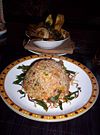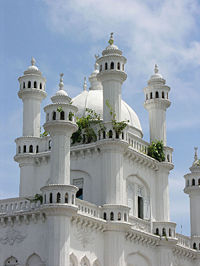Sri Lanka: Difference between revisions
imported>Minhaj Ahmed Khan Lodi m (→External links) |
imported>Minhaj Ahmed Khan Lodi m (→External links: -> alphabetical order) |
||
| Line 220: | Line 220: | ||
==External links== | ==External links== | ||
* [https://www.cia.gov/library/publications/the-world-factbook/geos/ce.html The CIA World Factbook - Sri Lanka] | |||
* [http://topics.nytimes.com/top/news/international/countriesandterritories/srilanka/index.html World news about Sri Lanka, including breaking news and archival articles published in the ''New York Times.''] | * [http://topics.nytimes.com/top/news/international/countriesandterritories/srilanka/index.html World news about Sri Lanka, including breaking news and archival articles published in the ''New York Times.''] | ||
==Bibliography== | ==Bibliography== | ||
Revision as of 18:42, 6 March 2008
| Democratic Socialist Republic of Sri Lanka | |
|---|---|
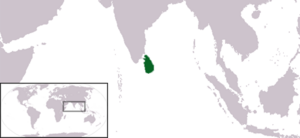
| |

| |
| National anthem | Sri Lanka Matha |
| Capital | Sri Jayawardenapura-Kotte |
| Largest city | Colombo |
| Official language | Sinhala, Tamil |
| Government type | Republic |
| President | Mahinda Rajapaksa |
| Prime Minister | Ratnasiri Wickremanayake |
| Area | 65,610 km² 25,332 mi² |
| Population | 20,926,315 (52nd) (2007 estimate) |
| Population density | 310/km² (35th) 818 mi² |
| HDI | Template:Decrease0.743 (medium) (99th) (2007) |
| Currency | Sri Lankan rupee (LKR) |
| Time zone | IST (UTC+5:30) |
| Country codes | Internet TLD : .lk Calling code : +94 |
Sri Lanka, officially named the Democratic Socialist Republic of Sri Lanka, is an island nation in South Asia, located about 31 km off the southern coast of India. It was known as Ceylon before 1972. It is also known as the Pearl of the Indian Ocean.
The official language is Sinhala, and Tamil enjoys national language status.
Tensions between the Sinhalese majority and Tamil separatists erupted into war in 1983. Tens of thousands have died in the ethnic conflict that continues to fester. After two decades of fighting, the government and the Liberation Tigers of Tamil Eelam (LTTE) formalized a cease-fire in February 2002 with Norway brokering peace negotiations. Violence between the LTTE and government forces intensified in 2006 and the government regained control of the Eastern Province in 2007, but neither side has formally withdrawn from the cease-fire.
Names of Sri Lanka
The local names of Sri Lanka are: Shri Lamka Prajatantrika Samajaya di Janarajaya and Ilankai Jananayaka Choshalichak Kutiyarachu. In short form, they are Shri Lamka and Ilankai. Prior to 1972, along with Ceylon, it was also known as Serendib. The present name is derived from the Sanskrit laṃkā meaning "resplendent land". The word Lamka was used in the Indian epics Mahabharata and Ramayana.
History
The ethnic origins of the island are highly controversial. Both the Sinhalese and the Tamils claim to have arrived first and therefore the other is an inerlooper. The evidence based on old epics is unconvincing to scholars. The Wanniyala-Aetto or Veddas as they're commonly known are believed to be the indigenous people of the island.
The first Sinhalese supposedly arrived on the island late in the 6th century B.C. probably from northern India. Buddhism was introduced in about the mid-third century B.C., and a great civilization developed at the cities of Anuradhapura (kingdom from circa 200 B.C. to circa A.D. 1000) and Polonnaruwa (from about 1070 to 1200). In the 14th century, a south Indian dynasty established a Tamil kingdom in northern Sri Lanka. The coastal areas of the island were controlled by the Portuguese in the 16th century and by the Dutch in the 17th century. The British arrived in Colombo in 1796 to assist the Kandyan king in removing the Dutch. They used Muslims as interpreters and trade experts. The British took Kandy in 1815, deposing the Sinhalese king.
The island was ceded to the British in 1796, became a crown colony in 1802, and was united under British rule by 1815. Ceylon became independent in 1948; its name was changed to Sri Lanka in 1972.
Politics and violence
Relations between the Sinhalese and Tamils were generally peaceful in the centuries before 1900. There was little interaction or intermarriage. A Ceylon National Congress had been formed in 1919 by an elite of Sinhalese and Tamil professionals, but it disintegrated in the 1920s. Ethnic tensions grew sharply in the 1920s as modernization brought larger visions to leaders from both groups and the creation of a democratic political system meant that the much larger Sinhalese group could dominate, if they remained united.
The Donoughmore constitution of 1931 was widely condemned and deeply unpopular, especially among the Tamils. The British Labour Party in London was in power and determined that all problems could be solved through democracy. The previous election was open to 4% of the people. London therefore introduced universal suffrage. The British goal was to shift politics away from caste, communal and class allegiances towards a broader national identity. While it provided a school for politicians, and helped modernize education and social services, the Sinhalese leadership became entrenched due to their solid majorities. Ceylon's pattern of communal politics based on ethnicity was stimulated and strengthened.[1] The British Parliament passed the Ceylon Independence Act of 1947, and Ceylon became an independent dominion and a member of the Commonwealth on Feb. 4, 1948.
Beginning in the mid-1950s, Sri Lanka's Sinhalese politicians began outbidding each other on who could provide the best deal for their community. This ethnic outbidding was initially influenced by linguistic nationalism, though it was soon also used to undermine agreements designed to accommodate the minority Tamils. The Sinhalese tolerated ethnocentrism and illiberal governance because this relatively deprived the Tamils even as it benefited their majority community. What they did not realize is that illiberalism cannot be compartmentalized and that eventually it affects the entire polity. This is indeed what happened over time. Consequently, interethnic violence has influenced intraethnic violence and the project that permitted dominating the minority Tamils along ethnic lines has now influenced Sinhalese politicians to dominate their fellows along political lines. This has led to a milieu where violence is now institutionalized as a way to settle political disputes even as ethnic outbidding continues and the civil war remains unresolved. The recent parliamentary elections, accompanied by massive violence and manifold irregularities, especially signify the illiberalism and political decay that have befallen the country.[2]
In Sri Lanka, the civil society sphere is shaped by colonial heritage, postcolonial structures of political patronage, and the growth of an NGO sector dependent on foreign funding. Civil society is geographically and ethnically divided and comprises struggles both in favor of and against a negotiated settlement to the violent conflict. While popular mobilization in the war zone is largely controlled by the guerrilla organization, limited spaces for dissent also exist.[3]
A widespread belief among Sinhalese is that minority northeastern Tamils are better off economically than the majority Sinhalese. This is a major cause of the ethnic violence that has gripped the country since the 1980s. However, evidence shows that any Tamil advantages after independence in 1948 were small and have been shrinking. There is significantly more socioeconomic inequality within the respective ethnic groups than between them.[4]
Sri Lanka has been in the grips of civil war since 1983. In 2002 a Memorandum of Understanding was signed between the government of Sri Lanka and the Liberation Tigers of the Tamil Eelam (LTTE), which set the terms and conditions of an indefinite ceasefire. During the peace process, 2002-05, violence continued, both along the same lines and in new forms. Three types of violence have been prominent during the peace process: 1) violence between the Liberation Tigers of Tamil Eelam (LTTE) and the government; 2) violence within the LTTE; and 3) violence between the LTTE and other Tamil groups. The 2002 ceasefire agreement by 2005 was in complete disarray. The civil war has restarted; at least 3,500 were killed in 2006 and "disappearances" are also increasing. This is a particularly difficult time for the civilian population trapped between the two sides. Analysts are uncertain whether or not either side has taken clear-cut strategic decisions or know what they hope to achieve during this unfortunate chapter in the civil war. Does the LTTE regard this phase as a prelude to something bigger, seeking to demoralize and weaken the government security forces prior to a major offensive? Or is this a frustrated reaction to a failed peace process and a major split in the LTTE ranks? What aims are the government seeking to achieve by paying so little attention to the impact of their assaultson innocent civilians in the north and east? Moreover, where does the international community turnnext? If there is to be a significant victory by either side, the major obstacle and challenge in the future will be legitimacy on the one hand and governance on the other.[5]
Geography and climate
Sri Lanka is located in Southern Asia, South of India. Its geographic coordinations are 7 00 N, 81 00 E. The total area of Sri Lanka is 65,610 sq km, out of which 64,740 sq km is land and 870 sq km is water. Sri Lanka has 1,340 km of coastline.
The northeast monsoon takes place from December to March, and the southwest monsoon takes place from June to October.
The terrain of Sri Lanka is mostly low, flat to rolling plain, and mountainous in the south-central interior. The highest point of Sri Lanka is at Mt Pidurutalagala, at 2,524 m. The natural resources of Sri Lanka are limestone, graphite, mineral sands, gems, phosphates, clay, and hydropower.
13.96% of Sri Lanka's land is arable, 15.24% consists of permanent crops. As of 2003, 7,430 sq km of Sri Lanka is irrigated.
Sri Lanka has occasional cyclones and tornadoes. The enviromental issues threatening Sri Lanka are deforestation; soil erosion; wildlife populations threatened by poaching and urbanization; coastal degradation from mining activities and increased pollution; freshwater resources being polluted by industrial wastes and sewage runoff; waste disposal; air pollution in Colombo.
Flora and fauna
Government
Sri Lanka is established as a democratic, socialist republic according to its constitution. It is a unitary state. The government is a mixture of the presidential and parliamentary forms of government. The head of state, commander in chief of the armed forces, as well as head of government is the president. The president is popularly elected to a 6 year term. The president appoints members of parliament into the cabinet of ministers.
The parliament of Sri Lanka is unicameral (one house) with 225 seats. Members of parliament are elected to a 6 year term by universal suffrage by district using a system of proportional representation. The president reserves the right to summon, suspend, or end a legislative session and dissolve Parliament any time after it has served for one year. The parliament reserves the right to make all laws.
Sri Lanka has had a multi-party democracy since 1931.
Provinces
Sri Lanka is divided into 8 provinces and 26 districts, which are administered by directly-elected provincial councils:
| Province | Capital | Districts | |
|---|---|---|---|
| 1 | Central | Kandy | Kandy, Matale, Nuwara Eliya |
| 2 | Eastern | Trincomalee | Ampara, Batticaloa, Trincomalee |
| 3 | North Central | Anuradhapura | Anuradhapura, Polonnaruwa |
| 4 | Northern | Jaffna | Alambil, Jaffna, Kilinochchi, Mannar, Mullativu, Vavuniya |
| 5 | North Western | Kurunegala | Kurunagala, Puttalam |
| 6 | Sabaragamuwa | Ratnapura | Kegalle, Rathnapura |
| 7 | Southern | Galle | Galle, Hambanthota, Mathara |
| 8 | Uva | Badulla | Badulla, Monaragala |
| 9 | Western | Colombo | Colombo, Gampaha, Kaluthara |
The districts are further divided into divisional secretariats.
Economy
Sri Lanka is mainly an agrarian country. The chief crop is rice with which the country is almost self-sufficient. Tea, rubber and coconut are also important crops, with tea being a major foreign exchange earner. Other crops of importance are cocoa and spices such as cinnamon, cardamom, nutmeg, pepper and cloves. Fruit and vegetables, native to both tropical and temperate regions, grow well in Sri Lanka. Sri Lanka is also a major exporter of precious and semi-precious stones. Within the last few years, remittances from Sri Lankans employed abroad have contributed a large share towards foreign exchange.
The last three decades have seen tourism emerge as an important industry. There has also been a rapid growth in manufacturing industries, which offer a wide range of export goods such as petroleum products, leather goods, ready-made garments and electronic equipment.
The garment industry is the leading manufacturing base in Sri Lanka. Since 1990, globalization, the phase-out of the Multi-Fiber Agreement, and regionalization have affected the development of the industry. In addition to the limited industrial development effects that result from the functional division of labor, regionalization makes it even harder to obtain market access. Analysts believe Sri Lanka is likely to continue to be tied to both the European and American trading blocks for the production of some good-quality and reasonably priced standardized garments for the middle market. However, this is a vulnerable position, especially when the market is flat. When manufacturers earn low levels of profits, the prospects of reinvestment in production and sustained industrial upgrading are negligible.[6]
Communications
As of 2007, the country has 2.7 million telephone land line users and 8.0 million cellular users. Telephone services have improved significantly and are available in most parts of the country. The national trunk network consists mostly of digital microwave radio relay. Fiber-optic links are now in use in around Colombo and 2 fixed wireless local loops have been installed. The combined fixed-line and mobile-cellular telephone density is about 50 per 100 inhabitants.
There are three radio broadcast stations: AM 15, FM 52, and shortwave 4. There are 14 television broadcast stations. There are 6,198 internet hosts (2007 est) and 428,000 internet users (2006 est).
Transport
As of 2007 there are 18 airports in the country, out of which 14 have paved runways.
Sri Lanka has 1,449 km of railway.
There are 97,287 km of roadways present in the country out of which 78,802 km is paved.
The waterways total 160 km (primarily on rivers in southwest).
Military
The Sri Lankan military is divided into three branches - the army, the navy and the air force.
The Sri Lankan military, has, during the British colonial era, participated in several wars, such as the Boer war, and both world wars. Since the outbreak of the civil war, the military has been engaged in fighting the LTTE.
Human rights
Demography
The population of Sri Lanka is 20,926,315. Since the outbreak of hostilities between the government and armed Tamil separatist in the mid-1980s, several hundred thousand Tamil civilians have fled the island and more than 200,000 Tamils have sought refuge in the West (July 2007 est.)
The languages spoken are Sinhala (official and national language) 74%, Tamil (national language) 18%, other 8%. English is commonly used in government and is spoken competently by about 10% of the population. 90.7% of the population is literate, 92.3% of males are literate, and 89.15 of females are literate (2003 census).
The ethnic composition of the nation is as follows: Sinhalese 73.8%, Sri Lankan Moors 7.2%, Indian Tamil 4.6%, Sri Lankan Tamil 3.9%, other 0.5%, unspecified 10% (2001 census provisional data).
The age structure of Sri Lanka is as follows:
0-14 years: 24.3% (male 2,596,295/female 2,495,949) 15-64 years: 67.9% (male 6,947,310/female 7,259,271) 65 years and over: 7.8% (male 765,507/female 861,983) (2007 est.)
The population growth rate of Sri Lanka is 0.982% (2007 est). The birth rate is 17 births per 1,000 of the population. The death rate is 6.01 deaths per 1,000 of the population. The net migration rate is -1.16 migrant(s) per 1,000 of the population.
The sex ratio of Sri Lanka is 0.971 male(s) per female. At birth it is 1.04 male(s) per female. Under 15 years it is 1.04 male(s) per female. Between the ages of 15-64 it is 0.957 male(s) per female. At 65 years of age and over it is 0.888 male(s) per female.
The infant mortality rate of Sri Lanka is 19.45 deaths per 1,000 live births. The male infant mortality rate is 21.2 deaths per 1,000 live births, and the female infant mortality rate is 17.63 deaths/1,000 live births. There are 3,500 adults living with HIV in Sri Lanka. As of 2003, there have been around 200 HIV-related deaths in the country.
The life expectancy at birth for the total population is 74.8 years of age, For males it is 72.81 years of age, and for females it is 76.88 years of age.
The fertility rate is 2.05 children born per woman.
Dissanayake (2003) examines mortality and morbidity rates in Sri Lanka. Before 1940, mortality was high because of epidemics of diseases such as cholera and malaria. Between 1940 and the 1970s, malaria was controlled and there were improvements in terms of nutrition, drugs, and medical services. After the 1970s, degenerative diseases replaced epidemics as the leading cause of death.[7]
Society and culture
Jazeel, (2003) undertakes a close reading of Anglo-Sri Lankan author Romesh Gunesekera's 1994 novel Reef. Jazeel explores the misplaced concreteness regarding Sri Lanka's status as an archetypal "island-state." Reef maps an imaginative geography which both naturalizes and problematizes Sri Lankan "islandness." Islandness emerges as a rationalization of modernity, one with its roots in Sri Lanka's colonial experience, which the author then picks apart as he proceeds to explore the limits of modernity. Reef demonstrates how islandness is an inescapable yet problematic dimension of contemporary Sri Lankan geography. An ambivalent contradiction fuels a civil war in Sri Lanka which relentlessly and sanguinely contests the integrity of Sri Lankan insularity. Gunesekera's hybrid position as an author born in Sri Lanka and now writing from England constitutes a postcolonial intervention that raises new questions about Sri Lanka's "natural" insularity.[8]
Cuisine
The staple food of Sri Lanka is rice and curry-boiled rice with curried vegetables. Sri Lankan curries are usually hot, sprinkled with lot of spices. Sri Lankan rice and curry usually include a variety of small curry dishes made of vegetables, meat, and fish. Chicken and fish are popularly used in curries, but beef and mutton are also used. Meals usually have an accompaniment such as parripu (red lentil dhal), mullung (ripped green leaves with spices, lightly stir- fried), and sambol (a mixture of grated coconut, chilly, and spice).
Sri Lankan history has left its imprints on Sri Lankan cuisine. Many regional foods are influenced by the Portuguese, the Dutch, the Malays, the Arabs, and the South Indians, all of whom have left their culinary impression in the island.
Sri Lankan cuisine offers a wide variety of desserts. A popular dessert is Kiribath, which is made of rice cooked in coconut milk, It is usually served on ceremonial occasions such as weddings. Other popular desserts are Wattalappam, which is an egg pudding, and Kiri Peni which is made of curd and honey.
Festivals
Cinema
Music
Religion
Sri Lanka is a religiously diverse nation. The religious composition of Sri Lanka is: Buddhist 69.1%, Muslim 7.6%, Hindu 7.1%, Christian 6.2%, unspecified 10% (2001 census provisional data).
The most popular religion in Sri Lanka is Theravada Buddhism. Most Sri Lankan Buddhists belong to this sect. Buddhism in Sri Lanka can be traced to Mahinda, son of Ashoka, who brought Buddhism to Sri Lanka in 246 BC. It is believed that he converted the King of Sri Lanka to Buddhism. Ever since, Buddhism had been encouraged in the nation by the royal dynasties, who welcomed missionaries. Many monasteries were constructed. Ashoka's daughter was believed to have brought a sapling of the Bodhi tree to Sri Lanka. Theravada Buddhism has remained the dominant sect in Sri Lanka even during periods of Mahayana influence. Many Buddhists also worship several indigenous Gods.
Islam was brought to Sri Lanka by Arab traders over the course of many centuries. Many followers of Islam in Sri Lanka are Tamil speaking, with others being descendants of Arab Moors and Malay settlers. Islam is very popular in the Eastern and Western coasts of the country, however, many Muslims had to move to the central highlands due to persecution by the Portuguese.
Thomas the Apostle was believed to have first brought Christianity to the island during the 1st century. However, Christian populations did not dramatically increase until converts were gained under the Portuguese during the 15th century. Dutch missionaries managed to convert 21% of the population to Christianity during the 17th century. However, Christianity declined at the end of the colonial rule.
Prior to the arrival of Buddhism on the island, Hinduism was the dominant religion practiced. It declined heavily, but managed to survive as various Oriya and South Indian dynasties conquered the island. Hinduism began to show signs of a resurgence with the settlement of Tamil migrants to the island. However, Hinduism still shows some signs of decline with conversions to Christianity.
The indigenous Wanniyala-Aetto or Veddas as they're commonly known follow a mix of animism mixed with nominal Buddhism in the interior parts and animism mixed with nominal Hinduism in the east coast, known as Folk Hinduism. One of the aspects of the Vedda religion is Ancestor worship. There are also particular deities unique to the Veddas, such as "Kande Yakka".
Media
Education
Sports
Famous Sri Lankans and residents
Perhaps the most famous resident of Sri Lanka is the British science-fiction and science-fact writer Sir Arthur C. Clarke, who has lived there since the 1950s. His 1979 novel The Fountains of Paradise is set in a fictional island country called Taprobane that closely resembles Sri Lanka; the history and culture of the island play an integral role in the story, which concerns the construction of a space elevator, aided by the island's proximity to the equator.
External links
- The CIA World Factbook - Sri Lanka
- World news about Sri Lanka, including breaking news and archival articles published in the New York Times.
Bibliography
Guides
- Cummings, Joe et al., Lonely Planet Sri Lanka (2006) excerpt and text search
- Gunawardena, C. A. Encyclopedia of Sri Lanka (2nd ed 2006) 1100 entries, 400pp
Economy
- Kelegama, Saman. Development under Stress: Sri Lankan Enonomy in Transition. (2006). 305 pp.
- Winslow, Deborah and Woost, Michael D., eds. Economy, Culture, and Civil War in Sri Lanka. (2004) 242 pp.
History
- De Silva, K.M. A History of Sri Lanka (2nd ed. 2005), 800pp; standard history by leading scholar
- Peebles, Patrick. The History of Sri Lanka (2006), 248 pp standard history by leading scholar.
- Perera, Nihal. Society and Space: Colonialism, Nationalism, and Postcolonial Identity in Sri Lanka (1998) online edition
- Philips, C. H. Historians of India, Pakistan and Ceylon (1961) online edition
- Spencer, Jonathan, ed. Sri Lanka: History and the Roots of Conflict (1990), essays by scholars; online edition
- Strathern, Alan. "Controversies in Sri Lankan History." History Compass 2004 2(Asia). Issn: 1478-0542 historiography online link
- Strathern, Alan. "Theoretical Approaches to Sri Lankan History and the Early Portuguese Period." Modern Asian Studies 2004 38(1): 191-226. Issn: 0026-749x
- Suckling, Horatio John. Ceylon: A General Description of the Island, Historical, Physical... (1876) full text online
Primary sources
- Ferguson, John. Ceylon in 1893: Describing the Progress of the Island Since 1803 (1893) 491 pages; full text online
Politics and violence
- Bullion, A.J. India, Sri Lanka and the Tamil Crisis, 1976-94; An International Perspective (1995)
- DeVotta, Neil. Blowback: Linguistic Nationalism, Instituional Decay, and Ethnic Conflict in Sri Lanka. (2004). 276 pp.
- DeVotta, Neil. "Ethnolinguistic Nationalism and Ethnic Conflict in Sri Lanka," in Fighting Words: Language Policy and Ethnic Relations in Asia Edited by: M.E. Brown, and S. Ganguly (2003)
- DeVotta, Neil. "Illiberalism and Ethnic Conflict in Sri Lanka," Journal of Democracy 2002 Vol. 13, p84-98,
- Orjuela, Camilla. "Civil Society in Civil War: the Case of Sri Lanka." Civil Wars 2005 7(2): 120-137. ISSN: 1369-8249
Fulltext: Ebsco
- Smith, Chris. "The Eelam Endgame?" International Affairs 2007 83(1): 69-86. Issn: 0020-5850 Fulltext: Ebsco
Society, ethnicity and culture
- Alwis, Malathi De. "The Changing Role of Women in Sri Lankan Society." Social Research 2002 69(3): 675-691. Issn: 0037-783x Fulltext: Ebsco
- Cartman, James. Hinduism in Ceylon (Colombo: MD. Gunasena 1957)
- Daswatte, Channa, and Dominic Sansoni.Sri Lanka Style: Tropical Design And Architecture (2006) excerpt and text search
- Gombrich, Richard F. Theravada Buddhism: A Social History from Ancient Benares to Modern Colombo (1988) online edition
- Jayaweera, Swarna, ed. Women in Post-Independence Sri Lanka. (2002). 371 pp.
- Kearney, R. N. Communalism and language in the Politics of Ceylon (1967)
- Kemper, Steven. Buying and Believing: Sri Lankan Advertising and Consumers in a Transnational World (2nd ed 2001) Drawing upon fieldwork conducted over thirty years, Kemper examines the Sri Lankan advertising industry to show how executives draw on their skills as folk ethnographers to "Sri Lankanize" commodities and practices to make them locally desirable, essentially producing new forms of Sri Lankan culture. excerpt and text search
- Manogaran, Chelvadurai. Ethnic Conflict and Reconciliation in Sri Lanka (1987)
- Manogaran, Chelvadurai, and Bryan Pfaffenberger, eds. The Sri Lankan Tamils: Ethnicity and Identity (1994), 247pp, essays by scholars online edition
- Roberts, Michael. "Tamil Tiger 'Martyrs': Regenerating Divine Potency? Studies in Conflict & Terrorism 2005 28(6): 493-514. Issn: 1057-610x
- Sriskandarajah, Dhananjayan. "Socio-economic Inequality and Ethno-political Conflict: Some Observations from Sri Lanka." Contemporary South Asia 2005 14(3): 341-356. Issn: 0958-4935 Fulltext: Ebsco
- Tambiah, S. J. Sri Lanka: Ethnic Fratricide and the Dismantling of Democracy (1986)
- Wilson, A. Jeyaratnam. The Break-up of Sri Lanka: The Sinhalese-Tamil Conflict (1988)
notes
- ↑ William Clarance, "Conflict and Community in Sri Lanka." History Today (July 2002), Vol. 52, Issue 7; online at EBSCO
- ↑ Neil Devotta, "Sri Lanka's Political Decay: Analysing the October 2000 and December 2001 Parliamentary Elections." Commonwealth & Comparative Politics2003 41(2): 115-142. Issn: 1466-2043 Fulltext: Ebsco
- ↑ Camilla Orjuela, "Civil Society in Civil War: the Case of Sri Lanka." Civil Wars 2005
- ↑ Sriskandarajah, "Socio-economic Inequality and Ethno-political Conflict" (2005)
- ↑ See Smith (2007)
- ↑ Hege M. Knutsen, "Globalisation and the Garment Industry in Sri Lanka." Journal of Contemporary Asia 2003 33(2): 225-250. Issn: 0047-2336 online edition
- ↑ Lakshman Dissanayake, "Mortality and Morbidity Trends and Poverty in Sri Lanka." Asian Profile2003 31(1): 37-46. Issn: 0304-8675
- ↑ Tariq Jazeel, "Unpicking Sri Lankan 'Island-ness' in Romesh Gunesekera's Reef." Journal of Historical Geography 2003 29(4): 582-598. Issn: 0305-7488
